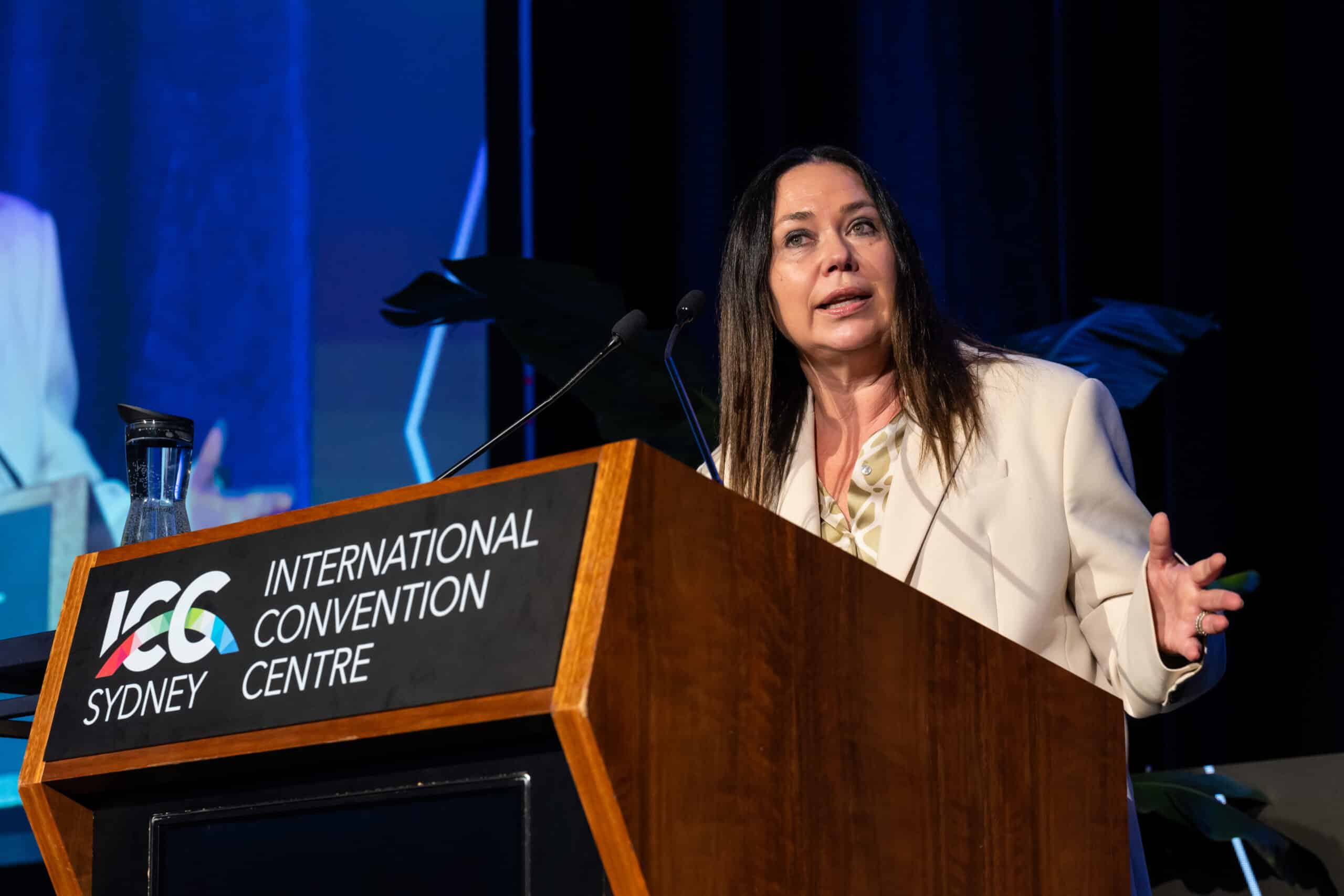It’s an honour to stand before you as we gather to discuss the state of retail, the challenges confronting us, and – importantly – exchange ideas and forge partnerships that will define the future of retail in Australia.
…To build our collective resilience.
And, to not only endure.
But thrive.
industry pulse-check…
We find ourselves at a pivotal moment for retail.
Over the past five years, the sector has been defined by disruption – from the ongoing impacts of the pandemic, and the rise of AI and digitisation, to economic and geopolitical uncertainty.
Retail has always been dynamic, but the economic headwinds endured by Australian retailers have made navigating business more complex than ever.
COVID changed everything and, ever since, we’ve had to recover, recalibrate, and rethink.
Now, we need to see a return to consumer and business confidence.
Many households have felt the sustained effect of high interest rates and elevated living costs on their personal finances.
The average Aussie is now pays almost $4,000 a month on their $640,000 mortgage. Homeowners have had to find an extra $2,000 a month just to cover their loan since the pandemic struck.
Unsurprisingly, findings from our recent ARA member research revealed:
- 65 per cent of retailers said consumer spending and confidence are the biggest barriers to growth.
- Most also said RBA interest rate decisions are ‘critically important to their business’.
Encouragingly:
- This week’s Roy Morgan figures have Australian consumer confidence up 4.7 points to 89.8, after the RBA’s first rate cut in over four years.
- Meanwhile, Business Confidence was up 2.3 points in January to 108.2 – the highest rating since April 2022, which suggests businesses are more optimistic.
- ‘Retail Trade’ was one of thirteen industries with confidence in positive territory, at 114.7 points – perhaps buoyed by Christmas trading.
While last week’s rate cut will provide relief for many households and businesses, we’re not home and dry.
Many economists and businesses expect the challenging market conditions to persist.
It will take time for this modest easing of interest rates to translate to greater discretionary spend.
On a positive note, in some sectors, consumers are treating themselves…
Beauty and wellness, and home improvement have shown resilience as Aussies continue to spend on personal wellbeing and home upgrades.
Sales in electronics and home furnishings are also projected to rise by 6 per cent as consumer confidence grows.
But, for the most part, we’ve seen shoppers spend selectively – cutting back on non-essentials, trading down, or waiting for the next discount event before committing to buy.
Last year saw subdued spending, punctuated by bursts of intensity mostly during sales events like Black Friday and Boxing Day.
- Black Friday bargain hunting was a boon to retailers in most categories, contributing to Aussies spending $37 billion on retail last November – up 3 per cent year-on-year.
While heightened discounting and price drops can be a shot in the arm for traffic and sales, it’s no silver bullet.
Striking the balance between competitive pricing, product quality and variety, and value-focused offers is a delicate mix. Especially in a highly competitive market where cut-price retail disruptors – like Shein and Temu – continue to grow their market share.
The cost of doing business is also weighing on retailers, especially in a low-productivity environment and with a lower Australian dollar.
- Higher costs absorbed by retailers – across leasing, wages, insurance, energy, goods, services and transport – puts pressure on margins and pricing strategies.
All this is compounded by a retail crime wave that continues to threaten the safety of our workforce and erode the bottom-line.
- The cost of retail crime has climbed 40 per cent in two years, costing some retailers almost 2 per cent of their annual turnover.
- 75% of the ARA members we surveyed said retail crime has increased.
- Almost one in every 10 retail crimes across Australia is violent.
- The impact to our teams cannot be overstated.
- Everyone deserves to feel safe when they go to work.
And we are navigating the biggest government workplace reforms in decades… in an election year.
Federal election agenda
With the federal election taking place by mid-May, we must acknowledge the critical role of government in ensuring our industry remains strong, resilient, and competitive.
A thriving retail sector is a barometer for economic health. 6
- Australia’s $430 billion retail sector is a cornerstone of our economy, contributing one-fifth of GDP.
- It’s the country’s biggest private sector employer, employing one in ten Australians, and dominated by small to medium-sized businesses; many family-owned.
- Yet, 65% of the ARA retailers we recently surveyed felt the government has been “unsupportive” or “very unsupportive” of business.
That’s why the ARA and NRA are calling on the government to recognise the sector’s immense economic contribution and provide the necessary support to unlock its full potential.
Our Pre-Budget submission for 2025-26 is headlined by three priorities:
- Embrace a Growth Mindset
- Grow the Retail Workforce
- Collaborate on Community Outcomes.
Turning challenges into opportunities
The reality is, 2025 will continue to test the endurance of every retailer.
How do we build customer loyalty, demonstrate value, strengthen productivity and build endurance for the future?
Within every challenge lies an opportunity for those prepared to adapt and innovate.
- Data and analytics:
We know retailers and consumers share concerns around collecting and managing data.
- Data can lead to poor decisions if its quality is inaccurate or incomplete.
- Data privacy and security expectations are increasing.
Cyberattacks are rising, and can lead to data breaches and reputational damage. Adairs, is one retailer who knows the power of data.
Their half-year results this week noted that Adairs’ one million Linen Lover members continue to account for 85 per cent of sales.
As we work to unlock customer lifetime value, the shift to data-driven decision-making is essential. And why retailers must invest in digital.
Many of our members are using creative, customer-centric strategies to incentivise spend and drive deeper engagement.
These tactics go beyond competing on price – with hyper-personalisation, exclusive experiences, bundled offers and loyalty programs building customer connections and business resilience.
- Having consolidated customer and Linen Lover data into one platform, the brand now has a single view of the customer.
- Leveraging this to evolve the Linen Lover program and enhance customer value, at scale, is a key priority – demonstrating a continued investment in data and digital to drive growth.
2. AI and automation
The AI hype is real.
“Artificial intelligence” has overtaken “digital media” and “customer loyalty” as the #1 theme in retail reports.
Petbarn made headlines last year with a first-of-its-kind Gen AI solution that offers tailored, vet-approved advice and extensive product recommendations.
Lack of trust in AI and automation – in other words, a preference for human interaction – can remain a barrier to adoption.
However, for many retailers, leveraging AI is a way to work smarter and be more productive – supporting scheduling, content generation, stock management and forecasting.
From AI-powered virtual assistants and website translations, to predictive insights and chatbots – AI is revolutionising the customer experience.
Retailers of all sizes are taking advantage of chatbot technology to handle product enquiries, order tracking and basic troubleshooting.
There’s even a chatbot to help you care for your beloved fur baby:
- Customers can use the intelligent assistant about vaccinations and nutrition, or training and quirky questions (like, “Is Vegemite safe for dogs?”) – on Petbarn’s website or app.
3. Sustainability and circular economy
Sustainable and ethical sourcing practices, and reducing waste, is now non-negotiable.
The challenge for retailers is to integrate sustainability into their business model without impacting the bottom-line.
Having a robust, transparent and circular value chain can help retailers improve efficiency, resilience, and competitiveness.
RFID, barcoding, blockchain tracking and GPS are all tools to track and trace goods.
- Coles proudly mentions on its site that its “own-brand Skipjack and Yellowfin canned tuna can be traced back to the approved fishing boat that caught the tuna, as well as the boat that transported it to the cannery.”
- Last September, Woolworths partnered with a supply chain mapping and regulatory software provider to trace its seafood supply chain.
Lastly, a circular value chain has the upside of lowering cost and creating less waste.
- The ARA has long-championed responsible retailing and sustainable business practices.
- We’re ecstatic to see retailers partner with organisations like Good360 Australia and Thread Together to help Australians in need, while supporting the circular economy.
Amalgamation of ARA & NRA into Australian Retail Council
As we enter the next critical growth phase for our sector, we must be more focused and aligned as an industry.
That’s why I’m delighted about the amalgamation of the Australian Retailers Association and the National Retail Association – which will become the Australian Retail Council.
With our combined strength, the ARC will be a one-stop shop that delivers more services to members and a stronger, unified voice for our sector.
One advocate for retailers of all sizes.
Needless to say, I’m incredibly excited for what the future holds.
Conclusion
We know 2025 is going to be a huge year for retail. Despite all the hurdles, Australian retailers have shown great resilience.
We are primed for growth. But it’s a marathon, not a sprint. That’s why endurance matters.
The future of retail is not something that will happen to us — it’s something we will create together.
Finally, you don’t have a business if you don’t have a team. I’d like to conclude by highlighting the exceptional retail teams that deliver for our businesses every day.
Our people are the lifeblood of our industry, and its their passion, innovation and dedication that empowers us to meet the changing needs of consumers, embrace what’s ahead, and endure.





















